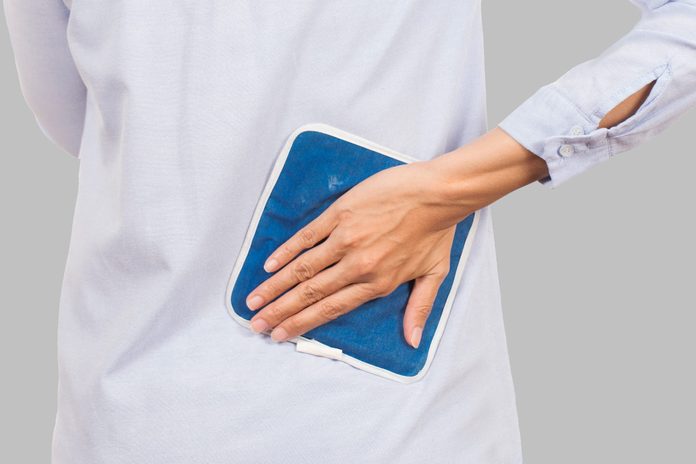Should You Use Ice or Heat for Back Pain? What Experts Say

Should you use ice or heat for lower back pain? Our experts weigh in, including the best ways to use ice and heat together.
Ice or heat? Heat then ice? Or ice then heat?
Exactly when, how, and for how long you should use ice or heat for lower back pain is a source of debate, and there aren’t always hard-and-fast rules.
Back pain will strike up to 80 percent of people at one point in their lives. It’s one of the most common reasons for missing work and the third most frequent reason to see a doctor, after skin problems and arthritis and joint disorders, according to a study in Mayo Clinic Proceedings.
Low back pain can be short-lived—lasting four to 12 weeks—or chronic, in which it persists for 12 weeks or more, according to the Centers for Disease Control and Prevention (CDC).
There is a laundry list of potential causes of low back pain: advancing age, underlying disease, overdoing it, lifting a heavy object the wrong way, a big fall, or even a minor slip, to name a few. And it can affect many structures in your back, including your vertebrae, joints, muscles, tendons, ligaments, and discs.
The cause of your lower back pain and the structures damaged both play a role in whether you’ll choose ice or heat during recovery.
(Related: A Guide to Back Pain Symptoms, Treatment, and Prevention)
Cold therapy
In general, apply cold to your back when the pain is acute, such as after an injury that just happened. This will help for the two days following your injury, according to the Arthritis Foundation. (Cold can also be helpful if your back aches after exercise.)
Here’s why it works: “Lowering the body temperature will help constrict the blood vessels, reduce swelling, decrease inflammation, and cause a numbing effect,” says Gbolahan Okubadejo, MD, a New York City-based spinal and orthopedic surgeon.
You can use a store-bought ice pack or make your own ice pack. Just don’t put ice directly on your back—it can damage your skin. Instead, keep a layer of clothing between the pack and your skin, or wrap the ice pack in a towel.
Apply cold for about 10 to 20 minutes a few times throughout the day. Be sure not to leave the cold packs on too long, and check your skin to make sure it’s not numb.
Sometimes cold is enough to give you relief.
(Related: I Tried a Theragun Massage Gun for Back Pain—Here’s My Review)
Cold, then heat
Sometimes, cold alone doesn’t cut it. In those cases, switch to heat once the inflammation has cooled, about two days later. “Use cold first and then apply heat for acute back pain,” says Okubadejo. “Do this for 48 hours after injury to relax muscles and soothe painful areas.”
Applying heat improves the flexibility of soft tissues, movement of muscles, and overall functioning of your back. “The warmth stimulates blood circulation in your lower back, which in turn brings healing nutrients to the injured tissues,” says Dr. Okubadejo. He suggests using heat therapy intermittently for several hours or days to improve tissue healing and prevent reoccurring pain.
Use a heating pad or a hot water bottle and mind the temperature to avoid burns. Moist heat (like a warm, damp towel or warm shower) penetrates deep tissues faster than dry heat.
Apply heat in short bursts—no more than 20 to 30 minutes at a time, according to the American Academy of Family Physicians. Set a timer if you’re afraid you’ll fall asleep, and always set pads on low or medium, never high.
(Related: How Pain Management Specialists Can Help You Treat Chronic Pain)
Heat therapy
When your back pain is chronic, heat therapy may be best. “Try continuous, low-level heat for chronic back pain,” Dr. Okubadejo says. He suggests wrapping a heated blanket around your lower back.
A heating pad is a good treatment option for certain symptoms of back pain, such as the painful muscle spasms that can occur with some back sprains and strains.
Muscle spasms come on quickly and cause your muscles to involuntarily tense up, says Jordan D. Metzl, MD, a sports medicine physician at the Hospital for Special Surgery in New York City and author of several books, including Dr. Jordan Metzl’s Running Strong: The Sports Doctor’s Complete Guide to Staying Healthy and Injury-Free for Life. Heat can loosen up your muscles, he says.
When to see a doctor
If your back pain persists, gets worse, or starts to get in the way of everyday activities, see a doctor to find out what is going on, Dr. Metzl says. Your doctor can run tests to find the cause of your back pain and suggest treatments in addition to heat and ice, including prescription or over-the-counter medications, steroid injections, or physical therapy.
Ice and heat aren’t usually meant to be stand-alone remedies for lower back pain, adds physical therapist Jake Magel, PhD, a research assistant professor at the University of Utah in Salt Lake City. Other treatments may be needed to relieve your pain and prevent it from coming back. “Generally, it’s an active approach with the goal of getting you back to your regular activities as soon as possible,” he says.
(Related: 6 Helpful Products for Lower Back Pain)
The last word
Heat and ice are important tools when you are recovering from a back injury or living with a chronic back condition. Use ice right after an injury and switch to heat two days later if you are still in pain. If your back pain is chronic, low-level heat may be helpful. Call your doctor to find out what else you can be doing if you are not getting better with rest, heat, ice, or over-the-counter medication.




